Brad Warner's Blog, page 6
December 5, 2011
Crazy Wisdom? Or Just Plain Nuts?
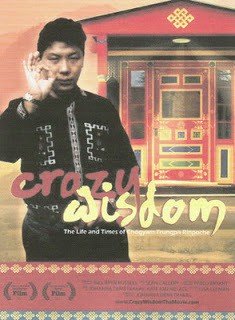
I just posted a new article on the Suicide Girls safe-for-work blog. It's called Crazy Wisdom - The Story of a Drunken Sex Pervert Who Revolutionized Buddhism.
It's about a new film called Crazy Wisdom. It's a documentary about the life and times of Chogyam Trungpa Rimpoche, the controversial Tibetan master who founded Naropa Institute in Colorado, the first Buddhist university in the Western world. Perhaps still the only Buddhist university in the Western world. He was Pema Chodron's teacher. He also set up the Shambhala Foundation. Trungpa's influence extends far and wide. I'm not even certain what his connection is with Shambhala Sun, for example. I keep running into organizations and people who have associations with Trungpa that I did not know about.
I gave the film a good review because I enjoyed it a lot. It has flaws. For all its openness about Trungpa's boozing and sex, it does gloss over a few things that I think are important. The filmmakers are followers of Trungpa, so it's to be expected they'd make a film that shows him in a mostly positive light. One could just as easily make a film that painted Trungpa to be evil, awful and nasty. In fact that movie might actually be a little easier to make.
Trngpa was mostly very honest about himself and the things that he did. I say "mostly" because there were some things he kept hidden. One of these was the advice he gave to his HIV positive successor Osel Tendzin that Tendzin would not transmit his illness to others as long as he did certain purification practices. This was nonsense, of course. And people have suffered greatly because of it.
Yet over all, Trungpa didn't present himself one way and behave another. Which is why I think he never was subject of any of the kinds of scandals some other Buddhist masters like Genpo Roshi, Eido Shimano, Richard Baker and the rest have been. Those guys' big mistake was the give people the idea that they were saintly in the conventional sense. Perhaps they never directly said they were, but they allowed people to build that sort of image around them. If anything Trungpa probably made himself sound worse than he really was.
Although I like the film, I'm still not sure about Trungpa himself. I know people who I respect and trust who knew Trungpa and think he was a terrible person. But then again, even these people will admit Trungpa wrote some good books and did some good stuff for a lot of people.
Oddly enough, just before I got the DVD screener of Crazy Wisdom in the mail from the producers for the purpose of writing the review, I watched a Discovery Channel documentary about Shoko Asahara, the cult leader responsible for the poison gas attack on the Tokyo subway system in 1995. The documentary is on YouTube. I'll put part one at the bottom of this blog entry. You should be able to find the other three parts pretty easily yourself.
I was struck by the ways in which Chogyam Trungpa resembled Shoko Asahara. There are several extremely important differences between the two men. The biggest difference is that Trungpa was trained and ordained in a legitimate Buddhist lineage. Shoko Asahara just pretty much made his credentials up. And Trungpa was wise as well as crazy whereas Asahara was just crazy and had no wisdom at all.
Still, it would be easy for someone to be fooled into believing Shoko Asahara was also an example of crazy wisdom and to excuse his weirdness for signs of deep enlightenment. Trungpa was openly a boozer. Asahara made no secret of his use of LSD. Trungpa had a legion of uniformed guards who served as a kind of Buddhist militia. Asahara had all kind of bizarre paramilitary operatives in his cult. Superficially one could site a number of points the two men had in common.
And yet even before the subway gas attack, I got a very very bad feeling from Asahara and his group (they had a little shop near one of the train stations I used to use frequently and I went in a few times). I never got that kind of ill feeling from Trungpa. I felt a little odd about him, but I didn't get the sense of real dangerous insanity that I got from Asahara's material.
Which is to say that I think one has to go with one's gut in these matters. Sometimes the superficial intellectual view seems to be fairly even when looking at several different spiritual teachers. And yet in the pit of your stomach you can kind of tell which ones are bad and which are okay. That is, if you learn to recognize your own intuition.
Published on December 05, 2011 08:06
December 1, 2011
Apology to Jay Garfield

A couple days ago I wrote to Jay Garfield and said, "When I submitted Nishijima Roshi's translation of Mulamadhyamakakarika to Monkfish Books, the title was Mulamadhyamakakarika. Nishijima Roshi had translated this as Song of the Fundamental Way. Monkfish Books said they didn't think that was a marketable title and asked if they could use the Sanskrit as the subtitle and re-title the book Fundamental Wisdom of the Middle Way. I was aware of MMK having been referred to by the English title Fundamental Wisdom of the Middle Way. So I OK'd the title change without checking any further as to its source. I had believed it to be just the standard English language title of the piece the way Bhagavad Gita is often called The Song of God or Maha Prajna Paramita Sutra is usually called The Great Heart of Wisdom Sutra.
"I should have checked. The only translations of MMK that I have are the ones by Inada and Kaluphana. I don't have yours (Garfield's translation of Mulamadhyamakakarika is also titled Fundamental Wisdom of the Middle Way). By which I mean no insult. I'm sure it's a terrific book. But I am just not a collector of books on Buddhism. I only have the Inada and Kalupahana translations because Nishijima Roshi gave them to me.
"In any case, I am now completely mortified by what has happened with regard to the title of the book. I am truly sorry for having accidentally copped your title. It wasn't meant to confuse the marketplace. It was just due to my own ignorance that this occurred."
I spoke with Paul Cohen of Monkfish Books about the matter yesterday. We have come to the following decision. The eBook version of the translation, which has not yet been released, will be published under the new title The Balanced State: A Heretical Retranslation of Nagarjuna's Root Stanzas of the Middle Way. When the current printing of the paperback (which is quite small) is sold out the book will be reprinted with that title. Furthermore the description of the book on Amazon will be rewritten as soon as possible so that the first line is, "This is not a standard translation of Nagarjuna's Mulamadhyamakakarika." I plan to refer to the book from now on under its new title (though I'll include the current title in parenthesis until the reprint becomes available).
Neither the folks at Monkfish nor I intended the current title as a way to deceive buyers or to ride on the coattails of the phenomenal success of Garfield's translation (I think it's now being made into a film with Robert Pattison from Twilight as Nagarjuna and Scarlett Johansson as his love interest). Paul Cohen's philosophy was that there were already several translations of MMK on the market but there was no agreed upon standard English rendering of the title. However, Garfield's title was very close to a straight rendering of the Sanskrit into English and it would do.
Here is how the Sanskrit title breaks down — mula: (noun) a root; basis, foundation, madhyamaka: (noun) middlemost, karika: (noun) concise statement in verse of doctrine. This has been variously translated as Root Stanzas of the Middle Way, Fundamental Verses of the Middle Way and so on. Given the fact that karika refers to verses about doctrine or philosophy, which is often seen as a kind of wisdom, one could argue that Fundamental Wisdom of the Middle Way is an acceptable, though somewhat loose English rendering of the Sanskrit title. Still, Garfield originated that title and I should have avoided using it*.
Even so, Nagarjuna's poem is reaching the point where it's about time an agreed upon standard English title emerged. As far as Paul Cohen was concerned, Garfield's title was already that. So why confuse the matter by re-titling the piece yet again? The idea that this title was chosen to cash in on a book that wasn't really a runaway success to begin with (no offense to Prof. Garfield intended) is ridiculous. The idea that I was lazy and ignorant about the matter does have some merit however.
The contents of the book will not be changed. They do not need to be changed. In the currently available version of the book my foreword makes it very clear that I do not know Sanskrit and cannot vouch for the reliability of the translation. In part I said, "The other writers who worked on the book before me left the project over disagreements they had with Nishijima's interpretation of Nagarjuna's Mulamadhyamakakarika. They said it was wrong, a mistranslation." That's in the first paragraph of the book.
Further along I said, "At the outset of my work on this book, Nishijima did try to get me to study Sanskrit. But I was already having enough trouble mastering everyday Japanese. Learning Sanskrit, a dead language that's a bear to learn and that I would only use for this one rewriting job, just didn't make sense. In any case, it didn't seem to be necessary for the task at hand. I decided my task in this book was simply to help convey what Nishijima has gleaned from his reading." I'm not sure how I could have been any clearer than that.
Nishijima's introduction, which follows this foreword, is very unambiguous about how he came to the conclusions he did regarding his translation. He admits being completely self-taught in Sanskrit. He tells you that he ignored all other translations both in English and Japanese. He cites exactly which dictionaries and grammar guides he used for his work. Furthermore, the book provides the original Sanskrit and word-by-word translations making it possible for readers to check the validity of Nishijima's word choices for themselves. You cannot possibly be more honest than that.
And, as I've said before, it's a very good book. Nishijima spent fifteen years slaving over his translation (here is a paper he presented in San Francisco in 1997 about his work on it**). This is not a lazy piece of hastily thrown together half-informed writing.
I was among the many people who advised Nishijima Roshi that he'd be far better off issuing this book as his reflections on Nagarjuna's work rather than as a translation. No one could argue against that. But he insisted it should be presented as a translation.
I think he knew exactly what he was doing. It may not have been what others, including me, thought he ought to be doing. But he was under no illusions that his translation would be accepted by scholars as accurate. He told me very clearly that he knew it would not. He expected hostility. He was ready for a fight. That's precisely what he wanted. He was quite explicit about that during our many conversations on the subject.
Why did he want such a thing? I wish he were well enough to answer that. But I can speculate. Nishijima Roshi has a bit of a punk rock attitude. That's what I like about him. If you tell a punk rocker he can't make an album unless he spends $20,000 at the Record Plant to work for six days with Steve Lillywhite on getting just the right snare drum sound he'll tell you to fuck off. Then he'll buy a $25 used cassette boom box at a Salvation Army store, set it up in front of his band, take the results to a local pressing plant, print up 500 copies and hand one to you while flipping you the bird.
The concrete results of this real action will force you to rethink your approach to recording in a way that no amount of reasoned theoretical argument ever could. It sure as hell worked in the music industry. The people in power said records like that would never sell. Now they've all lost their jobs and can't afford any more cocaine. Aw.
I think that Nishijima Roshi wanted to force people to re-examine Nagarjuna's Mulamadhyamakakarika. He believed this was so important that he was willing to risk trashing his own reputation to make it happen.
* Interestingly there is a book called The Sun of Wisdom: Teachings on the Noble Nagarjuna's Fundamental Wisdom of the Middle Way published by Shambhala in 2003 that also uses Fundamental Wisdom of the Middle Way as the English translation of Mulamadhyamakakarika. The description says, "The Fundamental Wisdom of the Middle Way was written in the second century and is one of the most important works of Nagarjuna, the pioneering commentator on the Buddha's teachings on the Madhyamika or Middle Way view." There's no mention of Jay Garfield as the originator of the translation of the title. There are no one-star reviews condemning the author for using it either. Maybe Paul Cohen was right after all...
** If that link doesn't work for you scroll down to the article titled Japanese Buddhism and the Meiji Restoration.
Published on December 01, 2011 09:40
November 23, 2011
Dave Materna for President
My upstairs neighbor Dave is running for President of the United States of America. Please lend him your support. Thank you.

Published on November 23, 2011 08:07
November 16, 2011
Trashed on Amazon
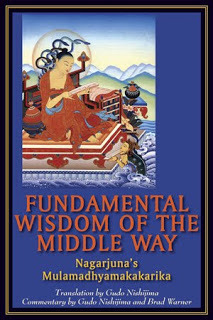
I'm in Manchester, England now. I'll be speaking here on Friday evening and running an all-day zazen on Saturday. You can find the relevant likes by clicking here.
Gudo Nishijima's translation and commentary on Nagarjuna's Fundamental Wisdom of the Middle Way is finally out and available now at decent bookshops all over the USA as well as on the and websites. I helped Nishijima fix up his English and contributed extensively to the commentary so I received a co-writer credit.
But speaking of Amazon, the book has been getting a total trashing in their reader reviews section. It's been so nasty and vindictive in there that I thought it would be good to address the matter.
There are now five extraordinarily mean-spirited and angry one star reviews of the book on Amazon. You can read them for yourself if you enjoy bile and vitrol. But I'll try to summarize the key issues here without quite so much bitterness.
The main criticisms appear to be that 1) some believe the book is presented in such a way as to deliberately fool people who want to buy Jay Garfield's translation of the same Nagarjuna poem into thinking this is his, and that 2) the book is not an accurate translation of the poem itself.
The first criticism is based on the fact that both Garfield and Nishijima chose to title their books Fundamental Wisdom of the Middle Way. This is one of the standard English translations of the Sanskrit title of the work, Mulamadhyamakakarika. While some scholarly translations such as the one by Kenneth Inada used the Sanskrit, Monkfish Books thought that would be too difficult for most readers and instead chose to go with a standard English translation. Other translations of the Sanskrit title include Root Stanzas of the Middle Way, Fundamental Verses of the Middle Way and Fundamental Song of the Middle Way. Personally I did not notice that the title was the same as Garfield's and that his was the only currently available English version that used this specific translation. Had I noticed this, I probably would have substituted something like "poem" for the word "wisdom" in the title. I regret having not done so, but it's too late to change it now.
Also some have said that the cover resembles the cover of the Garfield version. It's true. It does. It also resembles the covers of about 80% of all books on Buddhism these days. Monkfish followed the very standard practice of illustrating the cover with an ancient Chinese painting of the master who wrote the original piece. Pretty much every publisher follows this practice when designing a cover for a translation of an ancient Buddhist work.
In any case none of this was an attempt to deceive the public into thinking they were buying Garfield's translation. Why would anyone want to do that? It's not as if the Garfield translation sells in Harry Potter-like or Twilight-like quantities, thus making it attractive to try and copy. It's also not as if the intended readership are the kinds of people who'd buy the book without checking out who wrote it first. It's an absurd allegation, but one that is repeated in four of the five negative reviews on Amazon.
Some of the other allegations are similarly absurd. One reviewer states that, "Dogen, Godzilla, and Nishijima--the autonomic nervous system-- are all more fully present than Nagarjuna." Godzilla is mentioned once in my introductory essay in a sentence in which I apologize to readers familiar with my other books for not mentioning Godzilla in this one. There is one commentary in which Nishijima outlines his ideas about the autonomic nervous system. I quoted this commentary in full in an earlier posting on this blog, which can be found by clicking here and scrolling about halfway down the piece. This commentary is then referenced briefly several more times in later commentaries. Dogen is mentioned a lot. But Nishijima says right in his introduction, "My own thoughts regarding Buddhism rely solely upon what Master Dogen wrote about the philosophy. So when reading the Mulamadhyamakakarika it is impossible for me not to be influenced by Master Dogen's Buddhist ideas." Why then would it be surprising to find a lot of references to Dogen in the commentaries?
As for the book not being an accurate translation, this is a more complex issue. I address it in great detail in both my foreword and my afterword to the book. I have put those on a webpage so you can read them in full. Just click here.
In part I said there that, "We'll never know Nagarjuna's real intentions. We'll only ever know what his words mean to us. This book represents what those words mean to Gudo Nishijima." Further along I wrote, "Every translation of anything is an interpretation. For fifteen years I worked at a job where one of my main tasks was translating the dialogue of cheap Japanese monster movies into English. Even when doing this seemingly simple and straightforward work I had to change a lot of details to make them comprehensible to English speaking people. Nagarjuna's Mulamadhyamakakarika is a lot more complex than any monster movie. For one thing it is a poem. A poem isn't like an instruction manual in which there is only one correct way to interpret its meaning. There are as many ways to understand a poem as there are people to read it and all of them are valid in their own right."
I also said in the afterword, "I still don't know whether it will be accepted as a translation of Nagarjuna or not. I'm anticipating that a lot of scholarly types will debate its merits as a translation without ever giving the philosophical points contained within it much notice. If they do so, that would be a shame." This seems to be precisely what is happening. The current critics on Amazon don't really comment on the actual contents of the book. One even admits that he hasn't read it! Is it fair to criticize a book you have not even bothered to read?
Kumarajiva was a fifth century Indian scholar who translated many of the canonical works of Buddhism into Chinese. His translation of the Heart Sutra is still chanted in Buddhist monasteries all over the world. Nishijima contends that when it came to Mulamadhyamikakarika, Kumarajiva got it wrong. He simply did not understand what Nagarjuna was talking about. Furthermore, Nishijima contends that all later translations and commentaries have relied upon Kumarajiva's faulty understanding of the poem — even the very ancient ones. As evidence of this, Nishijima notes that Dogen quotes extensively from Nagarjuna's other works but never mentions Mulamadhyamikakarika, which is regarded as Nagarjuna's masterwork. This, he says, is because Dogen had access only to Kumarajiva's translation and found it lacking. Therefore Nishijima deliberately avoided consulting any other translations of the work either in English or in Japanese. It's no wonder then that his translation does not sound much like any of the others.
I said it before and I'll say it again, this is a damned good book. If you are interested in knowing what I learned in fifteen years of studying Buddhism under Gudo Nishijima, most of it is in this book. It is deep and difficult Buddhist philosophy. Nishijima Roshi believes that all of these ideas are present in Nagarjuna's poem. I trust that he found them there. But whether they are really there or not, I know that it's valuable stuff. If he found all of this philosophy in the wood grain of the wall he sat in front of every day for seventy years it would still be valuable stuff. Maybe he did but he thought it would be more believable to say he found it in Nagarjuna! (That's a joke, he was very methodical in his translation and he presents his translation methods to readers of the book very clearly. This is something few others have done.)
Some of you have written to me saying you've ordered the book or that you bought it in a store (hooray for you for supporting bookstores!). If you have read the book and you like it, please take a moment to go to Amazon and express your feelings. It would really help out a lot.
Thanks!
Published on November 16, 2011 11:35
November 14, 2011
Interview With Tricycle Magazine
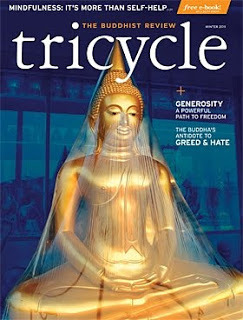
I'm on my way to England tomorrow. But here's an interview I did with Philip Ryan of Tricycle magazine for your entertainment. Who is that guy on the cover, though? That's not me! I'm gonna get my agent to speak to them...
Oh wait. I don't have an agent.
Poop.
Published on November 14, 2011 15:02
November 12, 2011
Sitting In Chairs Is Not Zazen (part one million and seven continued)
First I'll tell you a story. About three years ago I started getting emails from a guy I didn't know. He'd read my books. He said he was interested in Zen practice. But he had Multiple Sclerosis (MS). His disease had progressed to the point that he had lost most of his core body strength. He could barely sit in a chair let alone on a cushion. He asked what the alternatives might be.
We went back and forth in our emails for a while until we finally settled on a posture that involved him lying on his back on a hard surface with his hands in the traditional Cosmic Mudra. After that I lost contact with him.
About a year later a young guy I didn't know showed up at the Hill Street Center in Santa Monica where I led a weekly zazen meeting each Saturday. After we sat this guy told me that he was the son of the man with MS who I'd been writing to. He told me how happy his father had been with our conversations. He'd practiced zazen in the manner we discussed until he died. His son had come all the way to California to thank me.
This is what I'm talking about when I say it's not necessary to champion the cause of the physically disabled for doing zazen. People with non-standard abilities who are serious about practice will always find their own way. Always. Don't worry about them. Worry about your own practice.
Here's another story. A woman who came to the Hill Street Center for zazen practice told me how happy she was to be sitting with such an easy-going group. When she was seven months pregnant and living in New York City she visited one of the local zen groups. Pointing out her condition, she said that normally she sat on a cushion but asked if she might be allowed to use a chair. They told he no and showed her to the door. At Hill Street Center that day she sat on a cushion. She was no longer pregnant.
And now just a few general observations. In Japan I never once saw a zendo that even had accommodations for people to sit in a chair. I'm not sure what would happen if you asked to do so in your average Japanese Zen temple. I'm pretty sure they wouldn't be nice about it. The more traditional Zen temples in the US also don't have many such accommodations for chairs. There are a couple of spots in the corners at Tassajara where people can sit in chairs. Four maybe? As opposed to perhaps 80 or more spots on cushions. I never counted. The zendo at the City Center of the San Francisco Zen Center is similarly equipped. Sitting in chairs is allowed, but it's discouraged by limiting the numbers. The unspoken message is, "These few chairs are for those who really, honestly need them. If that's not you, sit on a cushion and leave the chairs for those who actually need them." They're sort of like the handicapped parking spots outside of Wal Mart in that sense.
I'm saying all this because some people read what I say about sitting on cushions and decide I am the cruelest and most heartless Zen teacher on Earth. Or else they assume I made the whole thing up, that I am the first and only person who ever said this. Furthermore they assume I am only saying this to be mean and nasty, to arbitrarily exclude the unfit from practice like some kind of Nazi dictator of Zen.
The truth is, I'm on the fairly liberal end of the spectrum when it comes to this. The reason it doesn't seem so is because certain of the meditation teachers who get popular and show up on the Internets are the kind who are inclined to make the practice as easy as possible in order to get the most butts on cushions or chairs or anywhere butts will fit. They'd tell you that you could meditate in a recliner if that'd get a few more people in the door. Most of these guys aren't from the Zen tradition. Some are from no tradition at all. But lots of folks these days just mix all the traditions into one and resent it when you tell them there are differences.
In the comments section of my last piece Rob Myers said, "My teacher, Jisho Warner (no relation) says 'You can sit in a chair; it's just harder.'" That's true. One of the most important points in zen practice is keeping the spine straight with little or -- preferably -- no support. It's a balancing act, like riding a bicycle. There's a reason bicycles aren't built with comfy reclining chairs on them. You'd fall over.
When you sit with your back against a chair, you are robbing yourself of that feeling of physical balance. And whenever I've attempted to do something like zazen in a chair, the chair has forced its own ideas of balance upon my body. There is no tilt to the pelvis and therefore no way to make the spine balance on its own.
Those kneeling chairs they make for people who work on computers all day can be modified to make a decent compromise. Because it's not really about how you screw up your legs. You don't have to sit in the full lotus position (I predict in the future at least 27 more people will say, "Brad Warner says you have to sit in the full lotus position" even after I say you don't 39 more times). It's just that the full lotus position creates a really, really stable base for the spine. There is a very good reason it's been a favorite for around 3000 years. Still, there may be other slightly less efficient but still acceptable ways to get the spine to balance.
The standard straight backed chairs you get at the local Furniture Hut are just not one of them. If you really honest to goodness need to sit on a chair you'll have to work a lot harder at zazen than those who sit on cushions on the floor.
Does anyone even care about this? Perhaps not. Not really. Those who want to argue will argue. Those who want comfort at all costs will reject zazen. Which is no problem as far as I'm concerned. Those who want to do practice will do practice.
* * *
Let me tell you about something really exciting!
I was at a used bookstore in Bruxelles yesterday and made the greatest score of my weird sci-fi ephemera collecting career. Just as I was about to leave I spotted a stack of old dusty magazines and decided to rummage through them on my way out. The mags turned out to be issues of Star Cine Cosmos, a French sci-fi mag from the early sixties. The guy wanted three euros each for them.
Among my haul was this issue featuring a cover photo that I think is from the film Planet of the Vampires.

Yet inside is a photo comic of the classic British giant-ape-on-the-loose movie Konga!!

Next up, this one features a cover painting clearly based on the British-made Godzilla rip-off Gorgo:

But inside it's actually a photo comic of the second Godzilla film Godzilla Raids Again aka Gigantis, the Fire Monster!


And finally the most amazing of all, a photo comic of my (almost) favorite film of all time Planeta Bur (Planet of Storms)!!!!

This is the Soviet-made sci-fi epic that later was cut up to become Voyage to the Planet of Prehistoric Women!!!




We went back and forth in our emails for a while until we finally settled on a posture that involved him lying on his back on a hard surface with his hands in the traditional Cosmic Mudra. After that I lost contact with him.
About a year later a young guy I didn't know showed up at the Hill Street Center in Santa Monica where I led a weekly zazen meeting each Saturday. After we sat this guy told me that he was the son of the man with MS who I'd been writing to. He told me how happy his father had been with our conversations. He'd practiced zazen in the manner we discussed until he died. His son had come all the way to California to thank me.
This is what I'm talking about when I say it's not necessary to champion the cause of the physically disabled for doing zazen. People with non-standard abilities who are serious about practice will always find their own way. Always. Don't worry about them. Worry about your own practice.
Here's another story. A woman who came to the Hill Street Center for zazen practice told me how happy she was to be sitting with such an easy-going group. When she was seven months pregnant and living in New York City she visited one of the local zen groups. Pointing out her condition, she said that normally she sat on a cushion but asked if she might be allowed to use a chair. They told he no and showed her to the door. At Hill Street Center that day she sat on a cushion. She was no longer pregnant.
And now just a few general observations. In Japan I never once saw a zendo that even had accommodations for people to sit in a chair. I'm not sure what would happen if you asked to do so in your average Japanese Zen temple. I'm pretty sure they wouldn't be nice about it. The more traditional Zen temples in the US also don't have many such accommodations for chairs. There are a couple of spots in the corners at Tassajara where people can sit in chairs. Four maybe? As opposed to perhaps 80 or more spots on cushions. I never counted. The zendo at the City Center of the San Francisco Zen Center is similarly equipped. Sitting in chairs is allowed, but it's discouraged by limiting the numbers. The unspoken message is, "These few chairs are for those who really, honestly need them. If that's not you, sit on a cushion and leave the chairs for those who actually need them." They're sort of like the handicapped parking spots outside of Wal Mart in that sense.
I'm saying all this because some people read what I say about sitting on cushions and decide I am the cruelest and most heartless Zen teacher on Earth. Or else they assume I made the whole thing up, that I am the first and only person who ever said this. Furthermore they assume I am only saying this to be mean and nasty, to arbitrarily exclude the unfit from practice like some kind of Nazi dictator of Zen.
The truth is, I'm on the fairly liberal end of the spectrum when it comes to this. The reason it doesn't seem so is because certain of the meditation teachers who get popular and show up on the Internets are the kind who are inclined to make the practice as easy as possible in order to get the most butts on cushions or chairs or anywhere butts will fit. They'd tell you that you could meditate in a recliner if that'd get a few more people in the door. Most of these guys aren't from the Zen tradition. Some are from no tradition at all. But lots of folks these days just mix all the traditions into one and resent it when you tell them there are differences.
In the comments section of my last piece Rob Myers said, "My teacher, Jisho Warner (no relation) says 'You can sit in a chair; it's just harder.'" That's true. One of the most important points in zen practice is keeping the spine straight with little or -- preferably -- no support. It's a balancing act, like riding a bicycle. There's a reason bicycles aren't built with comfy reclining chairs on them. You'd fall over.
When you sit with your back against a chair, you are robbing yourself of that feeling of physical balance. And whenever I've attempted to do something like zazen in a chair, the chair has forced its own ideas of balance upon my body. There is no tilt to the pelvis and therefore no way to make the spine balance on its own.
Those kneeling chairs they make for people who work on computers all day can be modified to make a decent compromise. Because it's not really about how you screw up your legs. You don't have to sit in the full lotus position (I predict in the future at least 27 more people will say, "Brad Warner says you have to sit in the full lotus position" even after I say you don't 39 more times). It's just that the full lotus position creates a really, really stable base for the spine. There is a very good reason it's been a favorite for around 3000 years. Still, there may be other slightly less efficient but still acceptable ways to get the spine to balance.
The standard straight backed chairs you get at the local Furniture Hut are just not one of them. If you really honest to goodness need to sit on a chair you'll have to work a lot harder at zazen than those who sit on cushions on the floor.
Does anyone even care about this? Perhaps not. Not really. Those who want to argue will argue. Those who want comfort at all costs will reject zazen. Which is no problem as far as I'm concerned. Those who want to do practice will do practice.
* * *
Let me tell you about something really exciting!
I was at a used bookstore in Bruxelles yesterday and made the greatest score of my weird sci-fi ephemera collecting career. Just as I was about to leave I spotted a stack of old dusty magazines and decided to rummage through them on my way out. The mags turned out to be issues of Star Cine Cosmos, a French sci-fi mag from the early sixties. The guy wanted three euros each for them.
Among my haul was this issue featuring a cover photo that I think is from the film Planet of the Vampires.

Yet inside is a photo comic of the classic British giant-ape-on-the-loose movie Konga!!

Next up, this one features a cover painting clearly based on the British-made Godzilla rip-off Gorgo:

But inside it's actually a photo comic of the second Godzilla film Godzilla Raids Again aka Gigantis, the Fire Monster!


And finally the most amazing of all, a photo comic of my (almost) favorite film of all time Planeta Bur (Planet of Storms)!!!!

This is the Soviet-made sci-fi epic that later was cut up to become Voyage to the Planet of Prehistoric Women!!!



Published on November 12, 2011 01:08
November 8, 2011
Sitting In Chairs Is Not Zazen (part one million and seven)
My interview on conscious.tv is up. But it's kind of hard to find. First you have to go to this page:
http://www.conscious.tv/nonduality.html
Then you'll get a screen that looks like this:
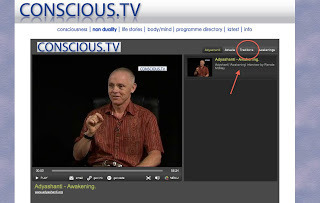
See how I've circled where it says "traditions" and put an arrow showing where it is? Click there and it takes you to another page and on the top of that page on the right hand side you'll see my interview. Click on me and enjoy! Or go to this convenient link and see if that works http://bcove.me/5evkpoh3. I'm embedding it at the bottom of this page, but I'm using a new program that I'm not totally sure about.
Today I am in Antwerp, Belgium. I caught the intercity rail out of Brentwood, Essex yesterday, changed to the Hammersmith & City tube line at Liverpool Street station, arrived at King's Cross/St. Pancras, made my way to the Eurostar line, took a train under the English Channel and soon arrived in Bruxelles Midi station. There my friend Isabelle and her sister Melissa picked me up and drove me to Antwerp with a quick stop for some frietjes covered in mayonnaise and ketchup.
This weekend I'll be running two events in Antwerp; a talk on Saturday and a day of zazen on Sunday. Information can be found at http://www.rsyoga.eu/. Go to that page, then click on "workshops," then click on "12-13 November 2011 - Brad Warner - Antwerpen" and it's all there in plain Dutch.
Last weekend I led a day of meditation in Brentwood, Essex. Let me tell you a little about that.
The Brentwood Meditation Group has been active since 2004. They have a lot of regular members who come each week to share silent meditation in a sort of ecumenical style, not tied to any particular tradition. Most of their members sit on chairs.
I was invited as a guest of this group to present what it is that I do to them. In this case, the fact that people were sitting on chairs was shoganai as we say in Japan. It can't be helped. It's just the way things are. What can ya do? Shoganai is a very useful and utterly untranslatable phrase.
In other words, I wasn't about to go in as a guest and tell a group who'd been practicing in some way that they couldn't do the thing they do the way they'd been doing it for years.
But I did tell them that sitting in chairs was not zazen. Zazen is a physical practice. To sit in a chair and call it zazen is incorrect. It's not that sitting on a chair will lead you to Satan and cause your eternal soul to burn forever in Hell. It's not evil. It's just not zazen.
It's like yoga. If you went to a yoga teacher and bent over slightly at the waist then told him, "THIS IS DOWNWARD FACING DOG! IT'S MY DOWNWARD FACING DOG! I DO MY DOWNWARD FACING DOG MY WAY!" Your yoga teacher would probably inform you that bending slightly at the waist is not downward facing dog. The position yogis call downward facing dog looks like this:

If you were really, really stiff your yoga teacher would work with you until your downward facing dog looked less like a slight bend at the waist and more like the photo above. But until you got into something at least a little like the photo, no decent yoga teacher would call that downward facing dog. It's not.
In the context of yoga it's easy for people to understand the difference between the two. But people tend to think of meditation as a mental activity. They tend to believe that the posture is just arbitrary, and that they can do zazen in any posture they like. They often tend to think that anyone who says otherwise is somehow taking away their inalienable right to do what they chose. But that's not true. Nobody's trying to take away your rights.
It's just that zazen looks like this:

You don't have to do the full lotus posture. Let me say that again since everyone seems to miss it when I say it:
You don't have to do the full lotus posture.
But you do need to be sitting on a cushion with your knees on the floor. Sometimes you can put extra cushions under your knees. You can also use a seiza bench, although I'm not the biggest fan of those. But that can be zazen too.
If someone really cannot do anything closer to zazen than sitting on a chair, well then that's shoganai too. They can sit on a chair. Tonen O'Connor, of the Milwaukee Zen Center is one of the best zazen teachers in America. She's had extensive knee surgery and she sits on a bench that's been modified to give her something close to the traditional posture (it's not a chair, though). But she's a special case. Maybe you are too. I don't know.
I do know this, though. I'll whisper it since it tends to make people mad when I say it.
(Sitting on a cushion with your knees on the ground is not that hard.)
Shhhhhhhhhh.....
There's a lot of bullshit cliches about the difference between Eastern and Western people. But one of the cliches that's not bullshit is that Western people are addicted to comfort. We really are. We bitch and whine and winge whenever our comfort is compromised. Most of the people I see who claim they can't sit zazen on a cushion fall into this category. They're just being big babies about it. They need to man-up (or woman-up or transgender-up) a little. It's just not that gosh darn difficult.
But I cannot enter your body/mind and know for sure whether you're really one of those very rare people who absolutely cannot sit on a cushion or if you're just one of those extremely common people who can do it but refuses to try. There's no way in the universe I can ever be 100% certain. Only you can know that.
Some people worry about those poor unfortunates who can't sit on the floor on cushions because of health issues or whatever. But y'know what? Every time I've spoken to someone who had honest health issues that prevented them sitting on cushions we've always managed to find a way. And the people who worry about hypothetical others that can't do it pretty much never are those people. Perhaps being the champion of hypothetical others isn't so important a job. They tend to be better spokespeople for themselves in my experience.
So this weekend in Antwerp and next weekend in Manchester, England I will be allowing people to sit in chairs if they insist upon it.
I'll be glad to have their participation.
I won't be mean to them or shout at them or tell them they're doing something wrong.
I don't bite.
I always allow people to do what they want as long as it doesn't disrupt others.
People sitting on chairs will be welcome to be with us and share in the experience in their own way.
But they won't be doing zazen.
Not a big deal. It just isn't zazen if you sit on a chair, unless there really honestly is no other way you can do it. That's all.

http://www.conscious.tv/nonduality.html
Then you'll get a screen that looks like this:

See how I've circled where it says "traditions" and put an arrow showing where it is? Click there and it takes you to another page and on the top of that page on the right hand side you'll see my interview. Click on me and enjoy! Or go to this convenient link and see if that works http://bcove.me/5evkpoh3. I'm embedding it at the bottom of this page, but I'm using a new program that I'm not totally sure about.
Today I am in Antwerp, Belgium. I caught the intercity rail out of Brentwood, Essex yesterday, changed to the Hammersmith & City tube line at Liverpool Street station, arrived at King's Cross/St. Pancras, made my way to the Eurostar line, took a train under the English Channel and soon arrived in Bruxelles Midi station. There my friend Isabelle and her sister Melissa picked me up and drove me to Antwerp with a quick stop for some frietjes covered in mayonnaise and ketchup.
This weekend I'll be running two events in Antwerp; a talk on Saturday and a day of zazen on Sunday. Information can be found at http://www.rsyoga.eu/. Go to that page, then click on "workshops," then click on "12-13 November 2011 - Brad Warner - Antwerpen" and it's all there in plain Dutch.
Last weekend I led a day of meditation in Brentwood, Essex. Let me tell you a little about that.
The Brentwood Meditation Group has been active since 2004. They have a lot of regular members who come each week to share silent meditation in a sort of ecumenical style, not tied to any particular tradition. Most of their members sit on chairs.
I was invited as a guest of this group to present what it is that I do to them. In this case, the fact that people were sitting on chairs was shoganai as we say in Japan. It can't be helped. It's just the way things are. What can ya do? Shoganai is a very useful and utterly untranslatable phrase.
In other words, I wasn't about to go in as a guest and tell a group who'd been practicing in some way that they couldn't do the thing they do the way they'd been doing it for years.
But I did tell them that sitting in chairs was not zazen. Zazen is a physical practice. To sit in a chair and call it zazen is incorrect. It's not that sitting on a chair will lead you to Satan and cause your eternal soul to burn forever in Hell. It's not evil. It's just not zazen.
It's like yoga. If you went to a yoga teacher and bent over slightly at the waist then told him, "THIS IS DOWNWARD FACING DOG! IT'S MY DOWNWARD FACING DOG! I DO MY DOWNWARD FACING DOG MY WAY!" Your yoga teacher would probably inform you that bending slightly at the waist is not downward facing dog. The position yogis call downward facing dog looks like this:

If you were really, really stiff your yoga teacher would work with you until your downward facing dog looked less like a slight bend at the waist and more like the photo above. But until you got into something at least a little like the photo, no decent yoga teacher would call that downward facing dog. It's not.
In the context of yoga it's easy for people to understand the difference between the two. But people tend to think of meditation as a mental activity. They tend to believe that the posture is just arbitrary, and that they can do zazen in any posture they like. They often tend to think that anyone who says otherwise is somehow taking away their inalienable right to do what they chose. But that's not true. Nobody's trying to take away your rights.
It's just that zazen looks like this:

You don't have to do the full lotus posture. Let me say that again since everyone seems to miss it when I say it:
You don't have to do the full lotus posture.
But you do need to be sitting on a cushion with your knees on the floor. Sometimes you can put extra cushions under your knees. You can also use a seiza bench, although I'm not the biggest fan of those. But that can be zazen too.
If someone really cannot do anything closer to zazen than sitting on a chair, well then that's shoganai too. They can sit on a chair. Tonen O'Connor, of the Milwaukee Zen Center is one of the best zazen teachers in America. She's had extensive knee surgery and she sits on a bench that's been modified to give her something close to the traditional posture (it's not a chair, though). But she's a special case. Maybe you are too. I don't know.
I do know this, though. I'll whisper it since it tends to make people mad when I say it.
(Sitting on a cushion with your knees on the ground is not that hard.)
Shhhhhhhhhh.....
There's a lot of bullshit cliches about the difference between Eastern and Western people. But one of the cliches that's not bullshit is that Western people are addicted to comfort. We really are. We bitch and whine and winge whenever our comfort is compromised. Most of the people I see who claim they can't sit zazen on a cushion fall into this category. They're just being big babies about it. They need to man-up (or woman-up or transgender-up) a little. It's just not that gosh darn difficult.
But I cannot enter your body/mind and know for sure whether you're really one of those very rare people who absolutely cannot sit on a cushion or if you're just one of those extremely common people who can do it but refuses to try. There's no way in the universe I can ever be 100% certain. Only you can know that.
Some people worry about those poor unfortunates who can't sit on the floor on cushions because of health issues or whatever. But y'know what? Every time I've spoken to someone who had honest health issues that prevented them sitting on cushions we've always managed to find a way. And the people who worry about hypothetical others that can't do it pretty much never are those people. Perhaps being the champion of hypothetical others isn't so important a job. They tend to be better spokespeople for themselves in my experience.
So this weekend in Antwerp and next weekend in Manchester, England I will be allowing people to sit in chairs if they insist upon it.
I'll be glad to have their participation.
I won't be mean to them or shout at them or tell them they're doing something wrong.
I don't bite.
I always allow people to do what they want as long as it doesn't disrupt others.
People sitting on chairs will be welcome to be with us and share in the experience in their own way.
But they won't be doing zazen.
Not a big deal. It just isn't zazen if you sit on a chair, unless there really honestly is no other way you can do it. That's all.
Published on November 08, 2011 01:08
November 3, 2011
ANIMALS AND FLY TIPPING

First off, the schedule for the Day of Zazen that I'm hosting up in Essex on this coming Saturday is at the bottom of this blog. I put up a tentative schedule a little while ago. This has now been revised.
Today is my last day in London. Last night I appeared on a programme (note spelling) called Conscious.TV taped in Battersea right near the cover of the Pink Floyd album Animals. I'm not kidding. I was walking to the studio and there it was! The cover to that Pink Floyd album! Right next to me. Gosh. Take a look at the photo I took (top) compared with the photo the folks at Hipgnosis took in the Seventies. There was no inflatable pig when I went by, unfortunately.
It turned out to be a night of rock and roll. The host of conscious.tv is a guy named Iain McNay. I had no idea, but Mr. McNay is the owner of Cherry Red Records, one of the UK's most important punk rock record labels. I've often bought stuff issued by that label. I would never have suspected that the guy who founded the label would now be hosting a TV programme devoted to non-duality. You just never know how these things happen.
It was a great interview. One of the best I've done. I accept a lot of interview requests. In fact, I rarely turn any of them down. I have no idea what any of them are going to be like. Sometimes the interviewers are absolutely clueless about what I do. Those are weird. I have no idea why they've even asked me on their shows. Sometimes the interviewer has some apparent agenda that they are hoping I'll support. Those can also be a bit uncomfortable. Sometimes the interviewers are extremely knowledgeable and have a lot of interesting questions. Those are the ones I like. And, in fact, most the interviews I do are pretty good. Iain McNay was one of the really good ones. The interview will be posted in a couple weeks and I'll put a link up when it is.
While in London I've stayed at my friend Andrew's flat in the picturesquely named London subsection of Shoreditch in Hackney. His place is on the Northern Line. There's fifty two stations on the Northern Line.
Andrew is a student of Mike Luetchford who is another dharma heir of Gudo Nishijima. Mike has been running a Zen group called Dogen Sangha UK out of Bristol for a number of years now. He was one of the first of Nishijima's students to go out on his own as a teacher. You can find info about the groups he set up in Bristol and London at their webpage. I highly recommend these guys if you're looking for a solid sitting group in the UK.
I'm feeling a whole lot better so I may just get through this tour after all! I walked all over London last night. Found a place that sells vegetarian fish and chips so I'm gonna go back there for lunch today.
 Finally, I need someone to explain this sign I took a photo of. It's not far from the Battersea power station. I understand that fly tipping is an offence (note spelling). But what is fly tipping?
Finally, I need someone to explain this sign I took a photo of. It's not far from the Battersea power station. I understand that fly tipping is an offence (note spelling). But what is fly tipping?Is it like cow tipping, a favourite sport in rural parts of America where teenagers go out at night and tip over sleeping cows? Do you sneak up on snoozing flies and gingerly push them over with your fingers? Or do flies in England work on a straight salary basis so it is illegal to tip them for their work? Or perhaps they don't want the flies to know where the juiciest garbage is, so it is therefore illegal to top them as to the location?
I must know the answer!!
****
DAY OF ZAZEN WITH BRAD WARNER
AT BRENTWOOD MEDITATION GROUP

9.30 Welcome with refreshments.
10.00 Group introduction, Brad's introduction
10.30 Zazen
11.00 Kinhin
11.15 Zazen
11.45 Brad's Dharma talk
12.45 Open forum
1.00 Shared lunch
2.00 Zazen
2.30 Kinhin
2.45 Zazen
3.15 Chanting
3.30 Tea
4.00 Zazen
4.30 Open forum, reflections of the day
Published on November 03, 2011 01:52
October 30, 2011
Tattoo You
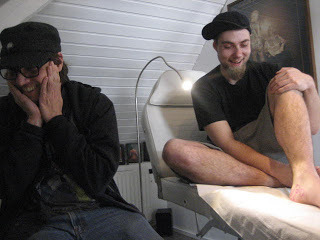 Gene Simmons bragged that KISS fans often got tattoos of the band. He said, "When you're in the KISS Army, you're in for life!"
Gene Simmons bragged that KISS fans often got tattoos of the band. He said, "When you're in the KISS Army, you're in for life!"I've already countered that boast by posting some photos from people who have had the cover images from my books tattooed on their bodies like this one and this one. But now I have an even better thing to brag about.
This afternoon I finished up a harrowing three-day zazen fest in the city of Bielefeld, Germany. Harrowing because I was pretty ill for the first day or so.
Remember that massive infection I told you about that I went to the hospital in Berlin for? Well, apparently something they gave me for that did not sit well with my body because I ended up covered in bright red itchy spots. So I spent a good portion of the first day of this retreat in yet another German hospital trying to figure out what the heck made me all spotty.
Turns out that no one knows. But they shot me up with cortisone and that seemed to help. The spots are now mostly gone.
 But in spite of my spotty condition, a group of about twenty intrepid meditators joined me for three days of zazen practice at a yoga studio here in Bielefeld. We lost one guy on the first day. I'm not sure exactly what the problem was. He just bolted some time while I was in the hospital. Perhaps I was too spotty for his liking. A couple other members of the group took the second day of the retreat off, having caught colds of their own. But both were back by day number three.
But in spite of my spotty condition, a group of about twenty intrepid meditators joined me for three days of zazen practice at a yoga studio here in Bielefeld. We lost one guy on the first day. I'm not sure exactly what the problem was. He just bolted some time while I was in the hospital. Perhaps I was too spotty for his liking. A couple other members of the group took the second day of the retreat off, having caught colds of their own. But both were back by day number three.But here's the funny part. One of the people who came to the retreat was this guy named Daniel. It turns out that Daniel had received a copy of the German edition of Hardcore Zen as a gift about a year ago. Iris, the person who gave him the book, had me sign it when I was in Bielefeld last year.
As I usually do, I drew a little Godzilla-type creature next to my signature. Daniel really liked the book and really liked the little Godzilla-type creature. He resolved that he was gonna get me to tattoo that creature on his leg.
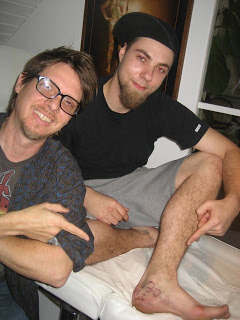 Of course, nobody informed me of any of this. But at the end of the retreat, Iris asked the group if anybody knew of a tattoo parlor in Bielefeld that might be open on a Sunday. It turns out that two of the people at the retreat, a couple, actually run a tattoo parlor in town. Iris told them what Daniel wanted. And they said they could help. They'd show me how to run the tattoo gun and I could tattoo Daniel, they said.
Of course, nobody informed me of any of this. But at the end of the retreat, Iris asked the group if anybody knew of a tattoo parlor in Bielefeld that might be open on a Sunday. It turns out that two of the people at the retreat, a couple, actually run a tattoo parlor in town. Iris told them what Daniel wanted. And they said they could help. They'd show me how to run the tattoo gun and I could tattoo Daniel, they said.I was pretty nervous about the idea. I have no tattoos and I have never even thought about tattooing anyone else. But Daniel really, really wanted this done. So I said I'd do it.
Even after we got to the tattoo parlor I tried to talk Daniel into having me just draw the monster on his ankle with a pen and have a professional trace it over with a tattoo gun. But he wasn't having it. It had to be by my own hand!
I got a quick lesson on how to use the tattoo gun and practiced a few times on some plastic "fake skin" material designed to react like actual skin to a tattoo gun. After a number of marginally successful attempts on that stuff I was as ready as I was ever gonna be.
 It was a pretty tense experience tattooing someone. I have no idea how real tattoo artists manage under that kind of pressure several times a day. Every fuck up I made will be etched into Daniel's skin for the rest of his life.
It was a pretty tense experience tattooing someone. I have no idea how real tattoo artists manage under that kind of pressure several times a day. Every fuck up I made will be etched into Daniel's skin for the rest of his life.Luckily I didn't screw it up too badly. The eyes are a bit more crossed than I would have liked and there's some unfortunate doubling up of lines on the tail. All in all, though, it came out pretty good I think.
But I'm not planning to make a career out of this!
Published on October 30, 2011 14:48
October 27, 2011
WHAT HAPPENS AT A ZEN RETREAT RUN BY BRAD

Today I'm about to start a three-day zazen retreat in the city of Bielefeld, Germany. After this I have one-day zazen retreats coming up in Essex, England on November 5, Antwerp, Belgium on November 13th and
Manchester, England on November 19th.
I'm not sure what people expect when they sign up for a Zen retreat with me. This has been my on-going concern throughout this tour.
A typical zazen retreat involves a lot of zazen and not much else. These days, though, you have a lot of what seem to me to be sort of "zazen lite" retreats. I blame Thich Naht Hanh. His most popular retreats, as I understand it, involve very little actual zazen practice but include a lot of fun activities.
This is certainly not the worst way a person can spend a day. And perhaps one or two of the hundreds of people who come to that kind of a retreat will take up a more serious practice. Which is not a bad thing.
But it's not a Zen retreat. At least not in the traditional sense.
The point of zazen is to do just one ridiculously simple activity in a very, very thorough way. You can explain all anyone needs to know about zazen practice in a couple of minutes. Here it is on line with a pretty girl demonstrating. Now you everything essential about zazen practice. I'm not trying to be funny here. This really is all anyone needs to know.
On this tour I've been trying to deal with numerous and widely differing sets of expectations. Some people are very hardcore about their Zen and view me as being way too easy. Some people are scared to death of zazen. They're like people at a swimming pool sticking their toes in and then screaming about how cold the water is. It's all they can do just to get through a half an hour of sitting, let alone a full day of it.
The only way to solve this problem is for me to simply do what it is that I do and let people decide for themselves if it's for them or not.
As I said earlier, I may, in future, devise a more introductory type retreat for those who are terrified of zazen. But for now, for the rest of this tour, I'm sticking to a somewhat more standard approach.
I think some people who read my books are shocked that I'm fairly traditional in my approach to the practice. But I always have been. And I think that comes through in the books if you read them carefully. So please don't be shocked if you sign up for a retreat with me and it's not a bunch of slam-dancing (aka moshing) and guys in monster costumes. More likely you'll be looking at a wall for a long, long while.
Here are the schedules for the upcoming retreats:
NOV. 5 ESSEX
10:00-10:30 Zazen
10:30-10:40 Kinhin
10:40-11:10 Zazen
11:10-11:15 Prepare for Service
11:15-11:30 Service
11:30-12:30 Dharma Talk
12:30-1:30 Silent lunch
1:30-2:00 Work or Free Time
2:00-2:30 Zazen
2:30-2:40 Kinhin
2:40-3:10 Zazen
3:10-3:20 Kinhin
3:20-4:00 Tea (silent)
4:15-4:45 Zazen
4:45 Chanting Refuges
NOV. 13 ANTWERP
09.30 - 10.00 aankomst/arrival
10.00 - 10.30 introductie/introduction, zazen+kinhin instructie/instruction
10.30 - 11.00 zazen
11.10 -11.20 kinhin
11.20 -11.50 zazen
11.50 - 12.10 koffie- or theepauze/coffeebreak (silent)
12.10 - 12.40 zazen
12.40 - 12.50 kinhin
13.00 - 14:00 lunchauze/lunchbreak
14.00 - 14.30 zazen
14.30 - 14.40 kinhin
14.35 - 15.00 zazen
15.00 – 16.00 lezing en vragen/talk and q and a
16.00 - 16.30 zazen
16.30 - 16.40 kinhin
16.40 – 17.00 afsluiting/conclusion (chanting refuges)
NOV. 19 MANCHESTER
10:00-10:30 intro to Zazen
10:30-11:00 Zazen
11:00-11:10 Kinhin
11:10-11:40 Zazen
11:40-1:00 Dharma Talk
1:00-1:45 Silent lunch –or folk can go and get lunch
1:45-2:15 Zazen
2:15-2:45 yoga
2:45-3:15 Zazen
3.15-3.30 Kinhin
3:30-3:45 chanting
3:45-4:00 finishing talk
4.00 finish
Published on October 27, 2011 01:29
Brad Warner's Blog
- Brad Warner's profile
- 595 followers
Brad Warner isn't a Goodreads Author
(yet),
but they
do have a blog,
so here are some recent posts imported from
their feed.



